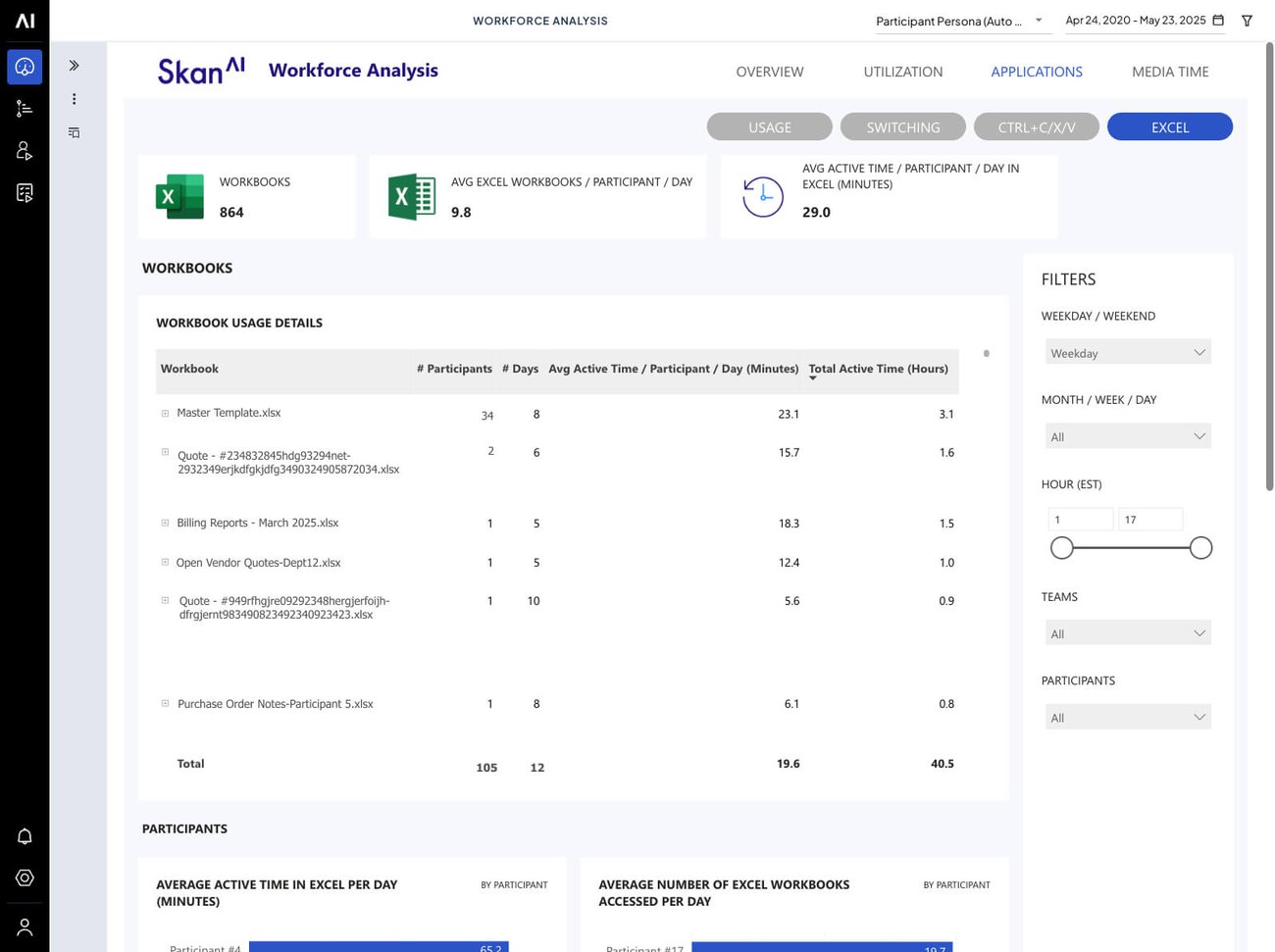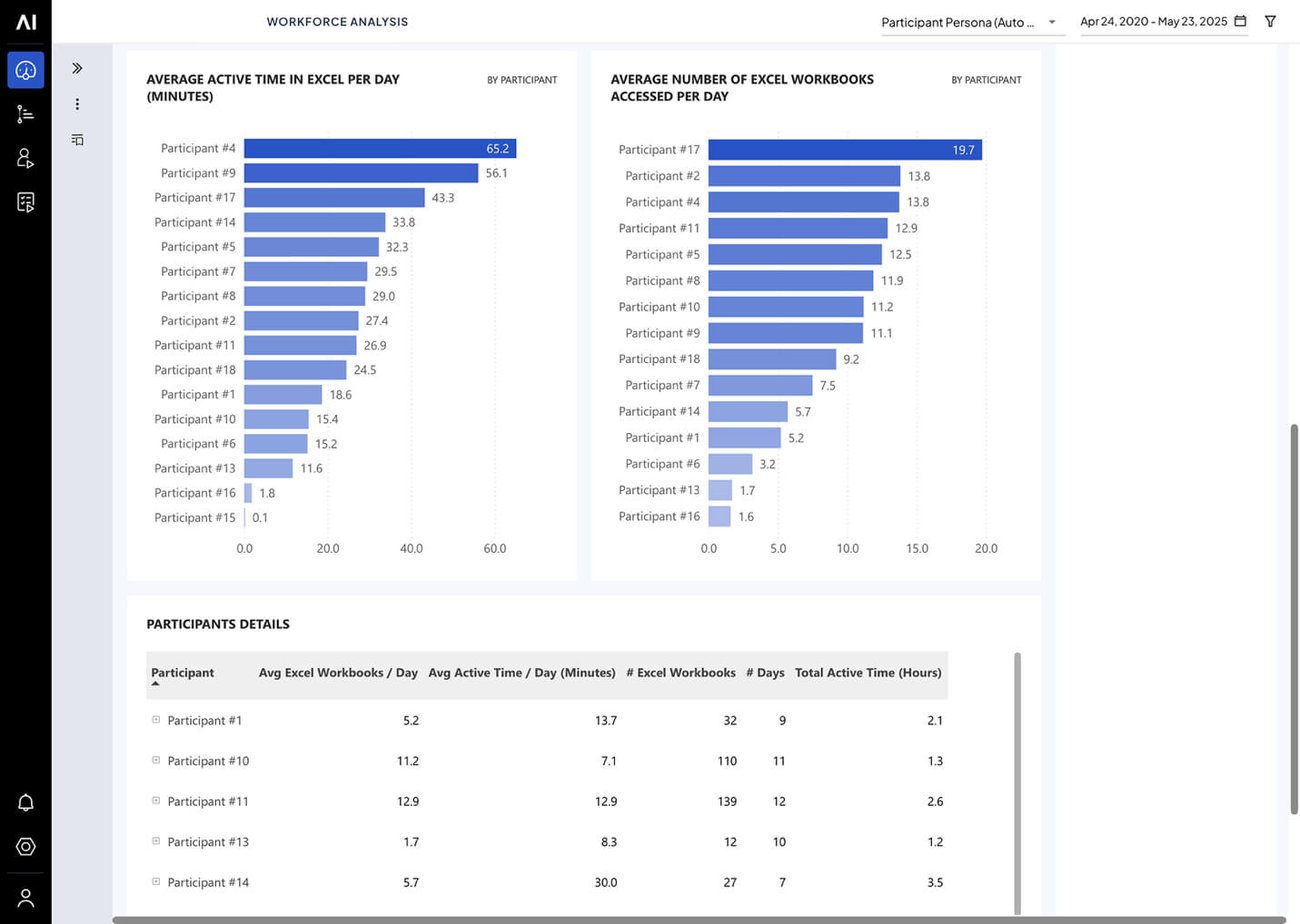Your employees are drowning in Excel.
Right now, someone at your company is copying data between spreadsheets for the third time today. Another person just spent 20 minutes reformatting a report they'll have to redo tomorrow. A third employee is manually entering numbers that could be pulled automatically. This isn't just happening once. It's happening thousands of times across your organization every single day.
Here's what most companies don't realize: Excel work that looks productive on the surface often hides massive waste underneath.
We've seen teams spend 40% of their time on repetitive Excel tasks that could be automated. We've found companies where simple application switching between Excel and other systems costs millions per year.
The problem isn't Excel itself. The problem is not knowing where the real bottlenecks are.
What Are The Most Common Ways Excel Hurts Productivity?
Our process intelligence platform can observe all applications, so we can create the most complete view of process work. Application usage is a big part of how we help companies become more efficient.
Time and time again, we see how "productivity" apps like Excel, Notepad, Teams, Word, etc hurt more than help. Excel is such a versatile application, so it's almost always near the top of application usage reports.
Let's look at the common ways we see Excel working against productivity optimization efforts from real-world use cases.
1. Manual Data Extraction and Report Generation
What We Uncover: Skan AI consistently reveals that teams spend excessive time manually extracting data from core applications into Excel spreadsheets, creating significant operational bottlenecks that remain invisible to traditional analysis methods.
The Opportunity: When these patterns are exposed, organizations can implement automated data extraction and report generation workflows to eliminate these manual processes.
Real-World Discovery: For a Fortune 100 US health insurance provider, our platform uncovered that teams were spending valuable hours in Excel. They were manually copying data into spreadsheets simply to validate information already available in their core applications. This insight enabled the organization to implement solutions that delivered $15 million in savings, allowing employees to focus on processing claims rather than time-consuming data entry tasks.
WATCH OUR EXCEL ANALYTICS OVERVIEW
2. Each Team Uses Excel Differently
What We Uncover: Our process intelligence technology reveals substantial variations in how teams use Excel across different locations, with processing time for identical tasks varying by as much as 3x-variations that often remain hidden from traditional process analysis.
The Opportunity: By identifying "trendsetters" within organizations-employees who process cases faster than their peers-organizations can implement these best practices across teams.
Excel performs many functions, but these are the few we see most often:
-
- Excel as a note-taking app: This is often a chance to standardize note-taking apps. Excel is not typically the best at this function and you probably have others in use.
- Excel as a copy / paste app: We often see teams needing to copy and paste data between disconnected systems. New or better integrations often remove this wasteful task.
- Excel as a calculator: This is a proper use of Excel to a degree. We typically find that primary applications should be doing the same math, but Excel is a workaround for subpar applications. We often encounter this scenario in quoting use cases.
Real-World Discovery: When analyzing a medical management department's Risk and Quality Assessment processes, we discovered teams spending an average of 25% of their time in Excel, with significant regional variations. This visibility enabled the organization to standardize Excel practices. They reduced Excel usage from 25% to just 5% across regions, and identified opportunities to save 2.5 million labor hours (equivalent to 800 full-time employees). This led to $27 million in savings for this department.
3. Excessive Application Switching Burden
What We Uncover: Our platform quantifies precisely how often employees toggle between applications, revealing that workers switch to/from Excel dozens of times per case in complex workflows. This creates substantial cognitive load and process inefficiency that remains invisible to process mining tools.
The Opportunity: Organizations can standardize Excel as the primary application for specific tasks and reduce copy-paste actions through targeted process redesign.
Real-World Discovery: For a Fortune 100 P&C insurance carrier, we identified significant inefficiencies, with underwriters averaging 47 toggles to and from Excel per case. This visibility enabled the organization to implement targeted standardization, reducing copy-paste actions from an average of 12 per case to just 7, resulting in a 45% reduction in processing time for renewals and approximately $12 million in annual savings.
4. Redundantly Repetitive Excel Tasks
What We Uncover: Skan AI finds teams often spend anywhere between 25-40% of their processing time in Excel, frequently on repetitive, low-value tasks that could be automated, far more time than organizational leaders typically realize.
The Opportunity: With this visibility, organizations can implement targeted automation of specific high-value, repetitive Excel tasks without requiring wholesale system replacements.
Real-World Discovery: For a business services company in the background screening industry, our platform identified numerous Excel processes that could be automated or streamlined. This visibility enabled the organization to implement changes that delivered $5.8 million in estimated annual savings from improved processing efficiency, plus an additional $7.2 million in annual savings from automation initiatives.
How it Works: A Look at our Excel Dashboard

How many workbooks are in use
-
- You can see exactly which Excel files your team opens and how often they use them. This helps you spot if people are using too many different files for the same work.
Avg workbooks used by day
-
- The dashboard shows how many Excel files each person opens daily, revealing workflow patterns. Some team members might be jumping between 10+ files while others stick to just 2-3.
Impact on active time
-
- You can measure how much time people spend in Excel versus other applications. This tells you if Excel work is helping productivity or slowing people down.
Each individual worksheet within a single Excel file
-
- The system tracks which specific tabs people use inside their Excel files. This shows you which parts of complex spreadsheets actually matter to daily work.

How individual participants are using Excel
-
- For those that are analyzing data at the individual level, seeing usage at the person level helps leaders understand where to focus standardization efforts so teams use Excel consistently and effectively.
PRIVACY NOTE: Skan AI can mask users and create groups for reporting, so individual identities can always be hidden through anonymization or grouping.
Key Insights Our Platform Reveals About Enterprise Excel Usage
Our process intelligence technology has revealed several essential patterns about Excel usage that apply across industries:
- Excel Dominates Workflows: We've seen teams spend up to 40% of their processing time in Excel, often significantly more than organizational leaders realize without process intelligence visibility.
- Geographic Variations: We consistently uncover up to 3x differences in Excel processing time across different regions and teams.
- Hidden Time Allocation: In compliance processes, over 50% of time can be spent on non-productive applications - Like Excel - rather than core processing work. Insights that traditional analysis methods cannot delivery.
The Savings Are Real
Our process intelligence platform has helped organizations identify substantial, documentable savings opportunities across enterprises:
- $146 million total savings identified for a Fortune 100 US Health Insurance Provider
- $12 million annual savings opportunities for a Fortune 100 P&C Carrier
- $14 million cost savings opportunities for a Fortune 500 Financial Services Company
- $11.3 million in potential savings for a Fortune 500 Enterprise
- $5.8 million efficiency gain opportunities plus $7.2 million in automation potential
Read these are more in our Case Studies section.
Ready to See How Skan AI Can Improve Your Team’s Use of Excel?
If your organization experiences high Excel usage, significant application switching, or process variations across teams, our process intelligence platform can help identify millions in potential savings opportunities. We don't implement solutions—we provide the visibility and insights you need to make informed decisions about optimization.
Discover the value hidden in your spreadsheets, waiting to be revealed.